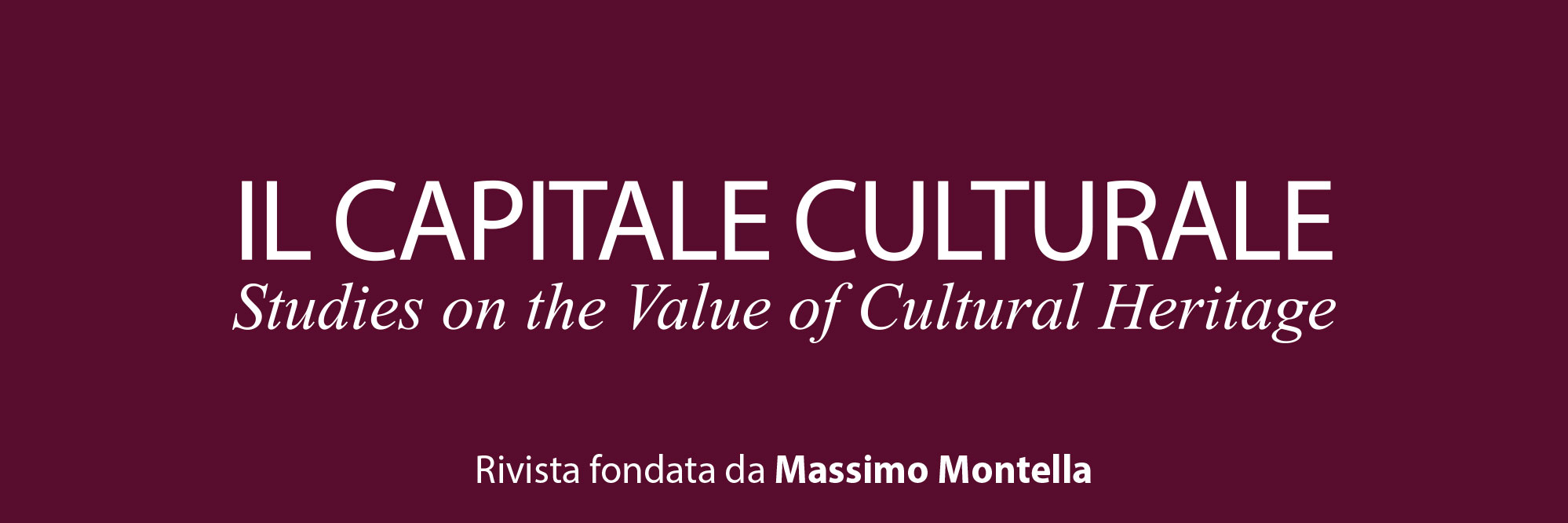Geografie del verde, geografie del gusto: riflessioni sull’attrattività turistica dei giardini/Geographies of green, geographies of taste: insights on the tourist attractiveness of gardens
Downloads
Additional Files
Pubblicato
Fascicolo
Sezione
Licenza
Tutti i materiali pubblicati sono coperti da copyright, mantenuto dall'Università di Macerata che ne supporta finanziariamente e tecnicamente la pubblicazione.
La licenza adottata è la Creative Commons - Attribuzione/Condividi allo stesso modo. Ovvero, gli autori che pubblicano su questa rivista accettano le seguenti condizioni:
- Gli autori mantengono i diritti sulla loro opera e cedono alla rivista il diritto di prima pubblicazione dell'opera, contemporaneamente licenziata sotto una Licenza Creative Commons - Attribuzione che permette ad altri di condividere l'opera indicando la paternità intellettuale e la prima pubblicazione su questa rivista.
- Gli autori possono aderire ad altri accordi di licenza non esclusiva per la distribuzione della versione dell'opera pubblicata (es. depositarla in un archivio istituzionale o pubblicarla in una monografia), a patto di indicare che la prima pubblicazione è avvenuta su questa rivista.
- Gli autori possono diffondere la loro opera online (es. in repository istituzionali o nel loro sito web) prima e durante il processo di submission, poiché può portare a scambi produttivi e aumentare le citazioni dell'opera pubblicata.
DOI:
https://doi.org/10.13138/2039-2362/3051Abstract
Giardini e turismo, un binomio che riporta a una storia densa e articolata di relazioni ed esperienze che affondano le proprie radici in epoche lontane, secondo modalità di visita e fruizione che hanno sedimentato e definito i contorni del cosiddetto, e più recente, garden tourism. Fenomeno noto e popolare in Europa, prodotto turistico consolidato in Inghilterra e Francia, trova ancora alcune resistenze in Italia in termini di proposte sistemiche e integrate a livello territoriale, rendendo i giardini delle “comparse”, piuttosto che dei “protagonisti”, nello scenario turistico delle destinazioni che cercano tempi e modi rinnovati per attrarre, depolarizzare, destagionalizzare i propri flussi.
In questa cornice, il presente contributo si interroga sulla capacità attrattiva e motivazionale dei giardini, eleggendo il caso di studio del Cusio, in Piemonte, quale campo di indagine condotta mediante un sondaggio creato ad hoc. Ciò consente di individuare richieste e percezioni dal lato della domanda turistica e possibili indicazioni da quello dell’offerta, al fine di declinare e promuovere il garden tourism nel contesto del Lago d’Orta, oggetto di indagine. Ne discende che le proposte di turismo dei giardini debbano basarsi su dati e necessità reali, che ne misurino la sostenibilità, ed essere correlate alle aspettative dei visitatori e alle potenzialità delle “risorse verdi” locali, che ne valorizzino il patrimonio.
Gardens and tourism, a combinational pairing that brings back to a dense and articulated history of relationships and experiences rooted in distant epochs, according to visiting and fruition modalities that have sedimented and defined the outlines of the so-called, and more recent, garden tourism. A well-known and popular phenomenon in Europe, a consolidated tourist product in England and France, it still finds some resistance in Italy in terms of systemic and integrated proposals at a territorial level, making gardens “extras” rather than “protagonists” in the tourist scenario of that destinations looking for renewed steps and ways to attract, depolarise and de-seasonalise their flows.
In this framework, the paper aims at questioning the attractiveness and motivational capacity of gardens, choosing the case study of Cusio, in Piedmont region, as the field of geographical investigation developed through a survey created ad hoc. This makes it possible to identify requests and perceptions on the tourist demand side and possible suggestions on the supply side, in order to promote the garden tourism in the context of Lake Orta, subject of the survey. It follows that garden tourism proposals have here to be based on real data and needs, which measure their sustainability, and correlate with the expectations of visitors and the potential of local “green resources”, which enhance their heritage.
Riferimenti bibliografici
Apostolakis A., Jaffry S. (2005), A choice modeling application for Greek heritage attractions, «Journal of Travel Research», 43(3), 309-318.
Augé M. (2007), Tra i confini: città, luoghi, integrazioni, Milano: Bruno Mondadori.
Augé M. (2018), Nonluoghi, Milano: Elèuthera.
Bottini L. (2022), Luoghi, eventi e turismo. Una prospettiva sociologica, Milano: Ledizioni.
Caporello M. (2019), Giardini Inglesi, la geografia del gusto in un secolo: Inghilterra 1630-1730, Tesi di laurea Magistrale in Storia delle Arti e Conservazione dei Beni Artistici, A.A. 2018/2019, Venezia: Università Ca’ Foscari.
Cerutti S. (2019), Geografie perdute, storie ritrovate: percorsi di partecipazione e sviluppo locale nelle Terre di Mezzo, «Rivista Geografica Italiana», 3, 57-80.
Cerutti S., Moroso S. (2022), Garden tourism. Il patrimonio dei giardini nei processi di fruizione e narrazione turistica, Roma: Aracne Editrice.
Cerutti S., Piva E. (2015), Il sistema turistico territoriale del lago d’Orta, in Candiotto R. (a cura di), Sistemi di governance dei bacini lacustri basati su piattaforme tecnologiche, Torino: Giappichelli Editore.
Connell J. (2004), The purest of human pleasures: the characteristics and motivations of garden visitors in Great Britain, «Tourism Management», 24, 2, 229-247.
Connell J. (2005), Managing gardens for visitors in Great Britain: a story of continuity and change, «Tourism Management», 26, 185-201.
Cutler S. Q., Carmichael B. (2010), The dimensions of the tourist experience, in Morgan M., Lugosi P., Ritchie B. eds., The tourism and leisure experience: Consumer and managerial perspectives (pp. 3-26), Bristol, England: Channel View Publications.
Gastal S., Beber A.M.C., César P.A.B. (2018), Garden tourism e jardins históricos: a natureza patrimonializada, «International Journal of Scientific Management and Tourism», 4-3, 109-119.
Hall C. M., Pag S. (2010), The contribution of Neil Leiper to tourism studies. Current Issues in Tourism, 13, 4, 299-309.
Kempiak J., Hollywood L., Bolan P., Mcmahon-Beattie U. (2017), The heritage tourist: an understanding of the visitor experience at heritage attractions, «International Journal of Heritage Studies», 23, 4, 375-392.
Larsen S. (2007), Aspects of a psychology of the tourist experience, «Scandinavian Journal of Hospitality and Tourism», 7, 1, 7-18.
Leiper N. (1990), Tourist attraction systems, «Annals of tourism research», 17, 3, 367-384.
Levi Sacerdotti S., Mauro S., Gasca E., a cura di (2011), Visitor Management. Turismo, territorio, innovazione, Torino: SiTI Torino, Politecnico di Torino Celid.
Lodari R. (2017), Atlante dei giardini del Piemonte, Novara: Libreria Geografica.
MacCannell D. (1976), The tourist: A new theory of the leisure class, University of California Press.
MacCannell, D. (2018), The symbolic power of the tourist attraction, «Via Tourism Review», 13. Available at: <https://journals.openedition.org/viatourism/2779>.
McMillan A.M., Plumptre G. (2019), National open Garden Scheme. Impact report, Available at: <https://ngs.org.uk/wp-content/uploads/2019/12/Impact-Report-2019-1.pdf>.
Martini U. (2015), Management dei sistemi territoriali: gestione e marketing delle destinazioni turistiche, Torino: Giappichelli Editore.
Nicosia E., Porto C.M. (2018), Governo partecipativo, promozione turistica e best practices nelle aree protette marchigiane, «Geotema», 57, 176-183.
Olsen D. H. (2013), A scalar comparison of motivations and expectations of experience within the religious tourism market, «The international journal of religious tourism and pilgrimage», 1, 1, 41-61.
Paiva P. D. D. O., Sousa R.D.B., Carcaud N. (2020), Flowers and gardens on the context and tourism potential, «Ornamental horticulture», 26, 121-133.
Pollice F., Spagnuolo F. (2009), Attrattività e sostenibilità: una lettura congiunta per lo sviluppo turistico locale. Turismo e psicologia, 2, 57-79.
Silva S., Carvalho, P. Tomás, P.M.C. (2013), Os jardins no contexto do turismo pós-moderno. O caso de Portugal, Pasos, «Revista de Turismo y Patrimônio Cultural», 11, 4, 631-647.
Splendiani S. (2017), Destination management e pianificazione turistica territoriale: casi e esperienze in Italia, Milano: Franco Angeli.
Uriely N., Yonay Y., Simchai D. (2002), Backpacking experiences: A type and form analysis, «Annals of Tourism Research», 29, 2, 520-538.
Zhang J., Walsh J. (2021), Tourist experience, tourist motivation and destination loyalty for historic and cultural tourists, «Pertanika Journal of Social Sciences and Humanities», 28, 4, 3277-3296.
Zoppi M. (1995), Storia del giardino europeo, Roma: Laterza.




